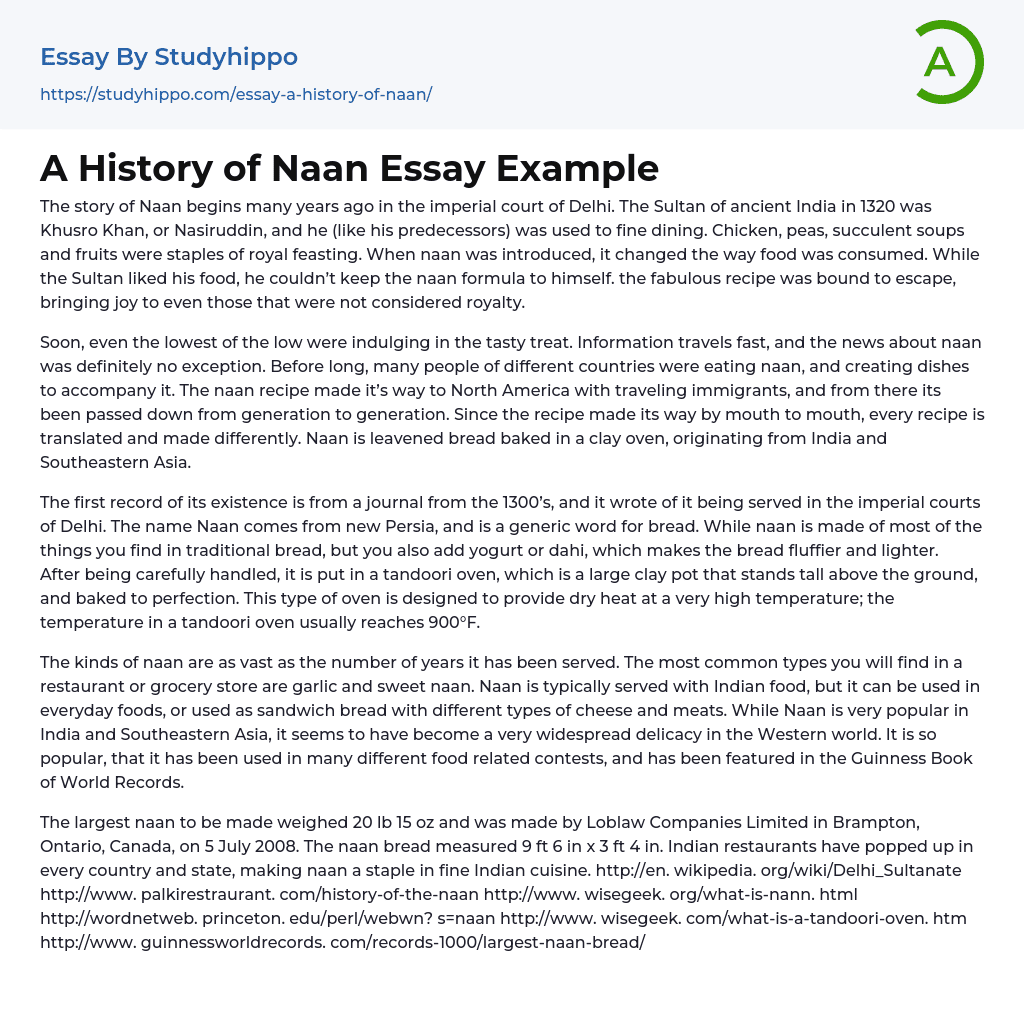The story of Naan begins many years ago in the imperial court of Delhi. The Sultan of ancient India in 1320 was Khusro Khan, or Nasiruddin, and he (like his predecessors) was used to fine dining. Chicken, peas, succulent soups and fruits were staples of royal feasting. When naan was introduced, it changed the way food was consumed. While the Sultan liked his food, he couldn’t keep the naan formula to himself. the fabulous recipe was bound to escape, bringing joy to even those that were not considered royalty.
Soon, even the lowest of the low were indulging in the tasty treat. Information travels fast, and the news about naan was definitely no exception. Before long, many people of different countries were eating naan, and creating dishes to accompany it. The naan r
...ecipe made it’s way to North America with traveling immigrants, and from there its been passed down from generation to generation. Since the recipe made its way by mouth to mouth, every recipe is translated and made differently. Naan is leavened bread baked in a clay oven, originating from India and Southeastern Asia.
The first record of its existence is from a journal from the 1300’s, and it wrote of it being served in the imperial courts of Delhi. The name Naan comes from new Persia, and is a generic word for bread. While naan is made of most of the things you find in traditional bread, but you also add yogurt or dahi, which makes the bread fluffier and lighter. After being carefully handled, it is put in a tandoori oven, which is a large clay pot that stands tall
above the ground, and baked to perfection. This type of oven is designed to provide dry heat at a very high temperature; the temperature in a tandoori oven usually reaches 900°F.
The kinds of naan are as vast as the number of years it has been served. The most common types you will find in a restaurant or grocery store are garlic and sweet naan. Naan is typically served with Indian food, but it can be used in everyday foods, or used as sandwich bread with different types of cheese and meats. While Naan is very popular in India and Southeastern Asia, it seems to have become a very widespread delicacy in the Western world. It is so popular, that it has been used in many different food related contests, and has been featured in the Guinness Book of World Records.
The largest naan to be made weighed 20 lb 15 oz and was made by Loblaw Companies Limited in Brampton, Ontario, Canada, on 5 July 2008. The naan bread measured 9 ft 6 in x 3 ft 4 in. Indian restaurants have popped up in every country and state, making naan a staple in fine Indian cuisine. http://en. wikipedia. org/wiki/Delhi_Sultanate http://www. palkirestraurant. com/history-of-the-naan http://www. wisegeek. org/what-is-nann. html http://wordnetweb. princeton. edu/perl/webwn? s=naan http://www. wisegeek. com/what-is-a-tandoori-oven. htm http://www. guinnessworldrecords. com/records-1000/largest-naan-bread/
- Food Safety essays
- Food Security essays
- Beverages essays
- Cuisines essays
- Dairy essays
- Desserts essays
- Fast Food essays
- Bread essays
- Meal essays
- Meat essays
- Organic Food essays
- Rice essays
- Sugar essays
- Taste essays
- Beef essays
- Coconut essays
- Crowd essays
- Dinner essays
- Juice essays
- Sainsbury essays
- Cooking essays
- Ginger essays
- Oreo essays
- Drink essays
- Beer essays
- Wine essays
- Coffee essays
- Tea essays
- Cake essays
- Hamburger essays
- Ice Cream essays
- Burger essays
- Pizza essays
- Fruit essays
- Lemon essays
- Food Waste essays
- Favorite Food essays
- Alcoholic essays
- Soft Drinks essays
- Cookie essays
- Starch essays
- Yeast essays
- Cola essays
- Pizza Hut essays
- snack foods essays
- chips essays
- Biscuit essays
- Brewing essays
- Brewery essays
- Russian Empire essays




